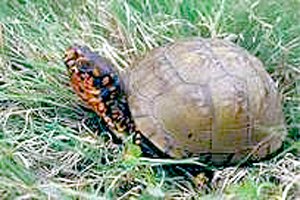The Missouri Department of Conservation encourages motorists to give turtles a brake. Be alert when driving to avoid hitting these slow and steady travelers crossing roads.
The Missouri Department of Conservation (MDC) encourages motorists to give turtles crossing roads a brake. Turtles are struck by cars throughout warmer months, but are at special risk this time of year because they are on the move. Young males make up most of the travelers as they search for territories of their own and for female turtles. Comfort is also a factor. Like other reptiles, turtles are cold-blooded so basking on warm asphalt feels good on cool spring days.
MDC encourages motorists to slow down when they see a turtle in the road and check to be sure they can safely steer around it. If helping a turtle cross a road, keep human safety as the number-one concern. Check for traffic and be sure to move the turtle across the road in the direction it was traveling.
The three-toed box turtle is the species most often seen crossing roads in Missouri. Primarily a woodland species, it is found everywhere but the extreme northern part of the state. It is so named because it has three toes on each hind foot, unless a few appendages have been taken by predators or frostbite.
The ornate box turtle is also a common traveler and is found in all but the southeastern corner of the state. It is more adapted to grasslands and is most common in western Missouri. Ornate box turtles usually have four toes per hind foot. In keeping with their name, ornate box turtles also have more vivid yellow stripes on a black background on the tops of their shells. The bottoms of their shells typically have streaks of black on a yellow background.
Box turtles spend their quiet lives eating plants, earthworms and insects. A hinged lower shell allows these reptiles to completely encase their head and legs, protecting themselves from most natural enemies. But autos kill thousands of turtles each year and are probably their biggest cause of death.
Box turtles can live for decades and females continue laying eggs for most of their lives. They need plenty of time to replace themselves since snakes, raccoons, opossums and other predators eat most of their eggs.
For more information about three-toed box turtles, visit the MDC online Field Guide at mdc.mo.gov/node/987. For more info on ornate box turtles, visit the Field Guide at mdc.mo.gov/node/7076.
Community on 05/28/2015
